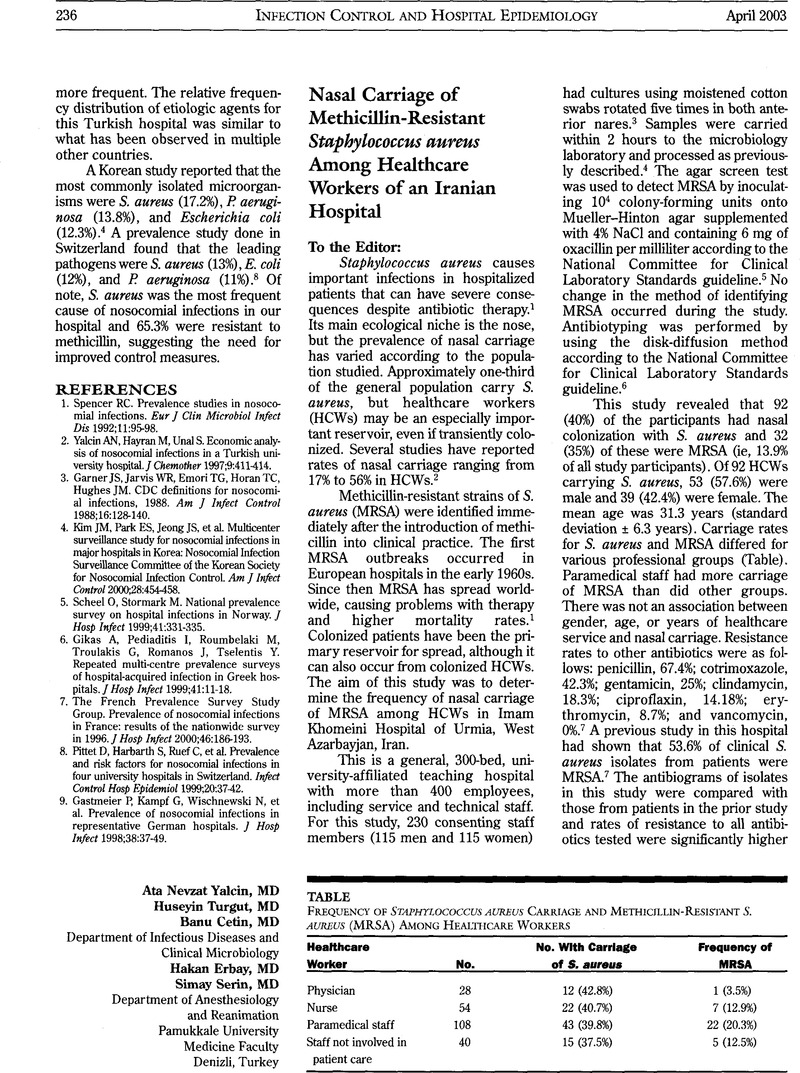Crossref Citations
This article has been cited by the following publications. This list is generated based on data provided by Crossref.
Rahbar, Mohammad
Yaghoobi, Mahmood
and
Kia-Darbandsari, Behnam
2006.
Prevalence of Nasal Carriage ofStaphylococcus aureusand Susceptibility of Isolates to Methicillin and Mupirocin Among Healthcare Workers in an Iranian Hospital.
Infection Control & Hospital Epidemiology,
Vol. 27,
Issue. 3,
p.
323.
Amorim, Maria L.
Vasconcelos, Carlos
Oliveira, Duarte C.
Azevedo, Ana
Calado, Elsa
Faria, Nuno A.
Pereira, Marta
Castro, Ana P.
Moreira, Alice
Aires, Ernestina
Cabeda, José M.
Ramos, Maria H.
Amorim, José M.
and
de Lencastre, Hermínia
2009.
Epidemiology of Methicillin-ResistantStaphylococcus aureus(MRSA) Nasal Colonization Among Patients and Healthcare Workers in a Portuguese Hospital: A Pre-intervention Study Toward the Control of MRSA.
Microbial Drug Resistance,
Vol. 15,
Issue. 1,
p.
19.
Askarian, Mehrdad
Zeinalzadeh, Alihosein
Japoni, Aziz
Alborzi, Abdolvahab
and
Memish, Ziad A.
2009.
Prevalence of nasal carriage of methicillin-resistant Staphylococcus aureus and its antibiotic susceptibility pattern in healthcare workers at Namazi Hospital, Shiraz, Iran.
International Journal of Infectious Diseases,
Vol. 13,
Issue. 5,
p.
e241.
Mamishi, S.
Mahmoudi, S.
Sadeghi, R. H.
Movahedi, Z.
Hadipour, R.
and
Pourakbari, B.
2012.
Genotyping ofStaphylococcus aureusstrains among healthcare workers and patients in the tertiary referral Children's Medical Hospital in Tehran, Iran.
British Journal of Biomedical Science,
Vol. 69,
Issue. 4,
p.
173.
Reisi, Maryam
Tajbakhsh, Elahe
Timuri, Reza Arjmand
Ghorbanpour, Koorosh
and
Momeni, Manouchehr
2014.
Molecular detection of the carriers of Staphylococcus aureus golden in referred to the Imam Ali Clinic in Shahrekord, Iran.
Asian Pacific Journal of Tropical Disease,
Vol. 4,
Issue. 6,
p.
493.
Emaneini, Mohammad
Jabalameli, Fereshteh
Rahdar, Hosseinali
Leeuwen, Willem B. van
and
Beigverdi, Reza
2017.
Nasal carriage rate of methicillin resistant Staphylococcus aureus among Iranian healthcare workers: a systematic review and meta-analysis.
Revista da Sociedade Brasileira de Medicina Tropical,
Vol. 50,
Issue. 5,
p.
590.
Emaneini, Mohammad
Beigverdi, Reza
van Leeuwen, Willem B.
Rahdar, Hosseinali
Karami-Zarandi, Morteza
Hosseinkhani, Faride
and
Jabalameli, Fereshteh
2018.
Prevalence of methicillin-resistant Staphylococcus aureus isolated from burn patients in Iran: A systematic review and meta-analysis.
Journal of Global Antimicrobial Resistance,
Vol. 12,
Issue. ,
p.
202.
Khnfar, Hussain Y. H.
Thaood, Dalal A.
Abdraba, Ilham O. A.
Omran, Intesar N.
and
Abdeldaim, Guma M. K.
2019.
Nasal and Hands Carriage Rate of Methicillin-Resistant Staphylococcus aure-us among Health Care Workers at Alwahda Hospital, Derna.
Al-Mukhtar Journal of Sciences,
Vol. 34,
Issue. 4,
p.
279.
Koupahi, Hossein
Honarmand Jahromy, Sara
Mardani, Masoud
Khodadadi, Ehsan
Rahbar, Mohammad
Eslami, Parisa
Mohammadzadeh Hashtrood, Mona
and
Saboorian, Roghieh
2023.
Detection of Methicillin Resistant Staphylococcus aureus (MRSA) by CHROMagar Versus Cefoxitin Disk Diffusion Method.
Iranian Journal of Medical Microbiology,
Vol. 17,
Issue. 2,
p.
251.





